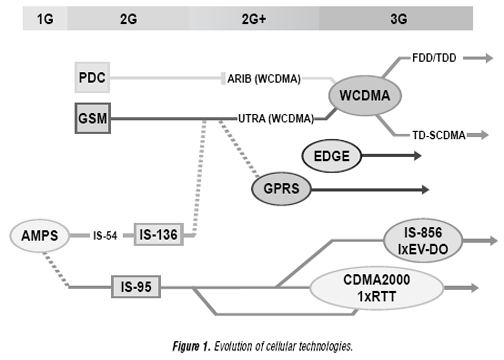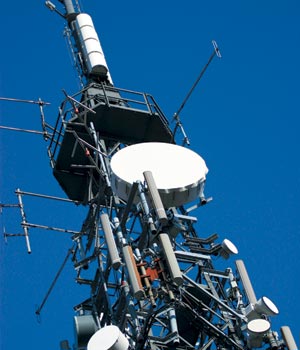Introduction
This is a practical Wideband Code Division Multiple Access (WCDMA)
measurement procedures note. The objective of this note is to present
measurement tips and procedures which will help a field-based network
technician or RF engineer conduct Node B measurements on WCDMA access
networks.
Evolution To WCDMA
In the mid 1980’s a second generation (2G) digital system known as the
Global System for Mobile Communications (GSM) was introduced for mobile
telephony. It significantly improved speech quality over the older
analog-based systems and, as it was an international standard, enabled
a single telephone number and mobile phone to be used by consumers
around the world. It led to significantly improved connectivity and
voice quality, as well as the introduction of a whole slew of new
digital services like low-speed data. Proving to be very successful,
GSM was officially adopted by the European Telecommunications
Standardization Institute (ETSI) in 1991. It is now widely used in over
160 countries worldwide.
The success of GSM spurred the demand for further development in mobile
telephony, and put it on an evolutionary path to third generation (3G)
technology. Along the way, that development path has included 2G
technologies like Time Division Multiple Access (TDMA) and Code
Division Multiple Access (CDMA). TDMA is similar in nature to GSM and
provides for a tripling of network capacity over the earlier AMPS
analog system. In contrast, CDMA is based on the principles of spread
sprectrum communication. Access to it is provided via a system of
digital coding.In 1997 a 2.5G system called the General Radio Packet
Service (GPRS) was introduced to accommodate the growing demand for
Internet applications. As opposed to the existing 2G systems, it
offered higher data rates and Quality of Service (QoS) features for
mobile users by dynamically allocating multiple channels. GPRS installs
a packet switch network on top of the existing circuit switch network
of GSM, without altering the radio interface.
In 1999, the International Telecommunications Union (ITU) began
evaluating and accepting proposals for 3G protocols in an effort to
coordinate worldwide migration to 3G mobile networks. These proposals
were known as International Mobile Telecommunication 2000 (IMT-2000).
One of the most important IMT-2000 proposals to emerge was Universal
Telecommunications Services (UMTS). While GPRS is considered the first
step in enhancing the GSM core network in preparation for EDGE and 3G,
WCDMA is a 3G technology according to the 3GPP standard (Figure 1). It
is the digital access system for the UMTS network and is today
considered one of the world’s leading 3G wireless standards.

|
Understanding WCDMA
WCDMA is an approved 3G technology which increases data transmission
rates via the Code Division Multiplexing air interface, rather than the
Time Division Multiplexing air interface of GSM systems. It supports
very high-speed multimedia services such as full-motion video, Internet
access and video conferencing. It can also easily handle
bandwidth-intensive applications such as data and image transmission
via the Internet. WCDMA is a direct spreading technology, it spreads
its transmissions over a wide, 5 MHz, carrier and can carry both voice
and data simultaneously. It features a peak data rate of 384 kbps, a
peak network downlink speed of 2 Mbps and average user throughputs (for
file downloads) of 220-320 kbps. In addition, WCDMA boasts increased
capacity over EDGE for high- bandwidth applications and features which
include, among other things, enhanced security, QoS, multimedia
support, and
reduced latency (Table 1).
| Parameters |
WCDMA |
| Bandwidth |
5MHz |
| Chip Rate |
3.84 Mcps |
| Power Control Frequency |
1500Hz up/down |
| Base Station Synchronization |
Not needed |
| Cell Search |
3-step approach via primary ,secondary search code and CPICH |
| Downlink Pilot |
CDM common (CPICH)
TDM dedicated (bits in DPCH) |
| User Separation |
CDM/TDM (shared channel) |
| 2 G Interoperability |
GSM-UMTS handover (Multi-mde Norminals) |
WCDMA networks offer a number of significant benefits. They are:
• High bandwidth and low latency which contributes significantly to a
higher-quality user experience and in turn increases data revenue and
improves customer satisfaction.
• Support for a wide array of new and emerging multimedia services.
• Considered the most cost-effective means of adding significant capacity for both voice and data services.
• Far better integration of RF components in the base station as
compared to any other radio or mobile technology. A WCDMA base station
cabinet has several times the RF capacity of GSM cabinets.
• Extreme flexibility in allocating capacity to offer the optimal QoS
for different traffic types. To date, WCDMA has been adopted for 3G use
as specified in the 3GPP standard by ETSI in Europe, and as an ITU
standard under the name “IMT-2000 direct spread.” NTT DoCoMo launched
the first WCDMA service in 2001 and now has millions of subscribers.
WCDMA (UMTS) is also the 3G technology of choice for many GSM/GPRS
operators, with dozens currently in trials. More than 100 GSM/GPRS
operators have even licensed new spectrum with the intent to launch
WCDMA services in the coming years.
TOP » Next»
|




